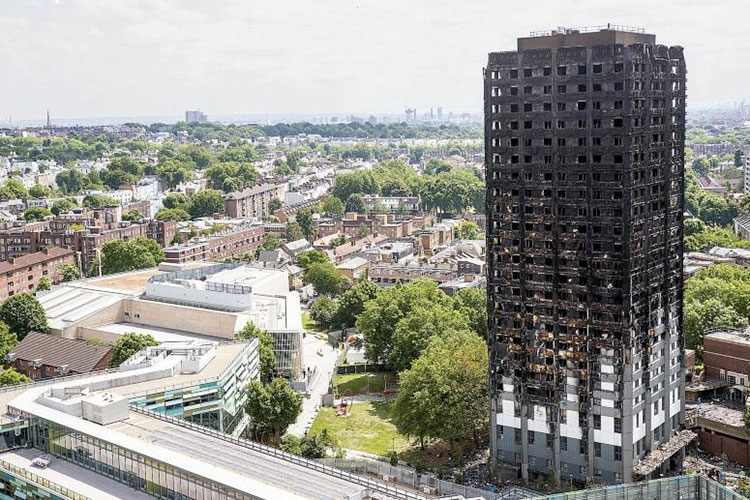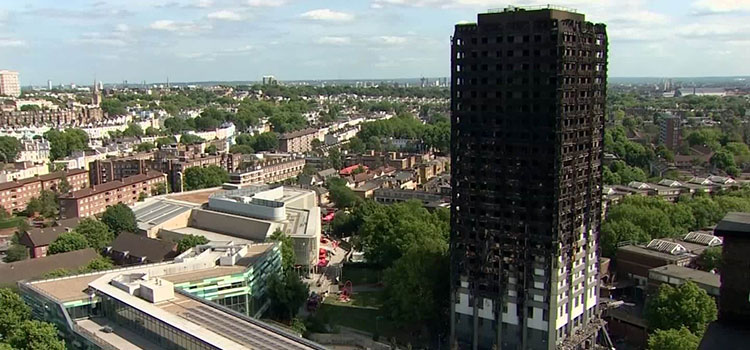What can the Machine Safety sector learn from the Grenfell Tower Tragedy?

Unfortunately, most of us are familiar with the tragedy of Grenfell Tower which occurred in June 2017. While the country is still shocked and deeply saddened that this tragedy occurred, the main question is this;
‘Why and how was this allowed to happen?’
At Spiers Engineering Safety we can see some uncomfortable parallels with the machine safety industry. This article is intended to highlight those parallels in the hope that the consumer will make decisions that drive change.
Cladding is a material that is wrapped around a building to make it look more uniform and attractive. It also has the benefit of added insulation and is popular with developers as a cost efficient way of improving the aesthetics of a building. It has been widely reported that the reason fire spread so quickly at Grenfell tower is because the cladding used was not as fire retardant as it should have been.
Let’s take a look at the known factors in play here:
Saving Money
It is an unavoidable truth that there will always be a careful balance struck when cost vs. risk benefit is taken in to account. This is normally done as a part of a wider cost benefit analysis to determine what is reasonably practicable. Regardless of the outcome, all parties must comply with the law.
Often, when the customer (in this case, the council) is presented with a large cost, some resistance will be applied to the purchasing/procurement process. This is normal, and is a necessary function of procurement to ensure that money is spent wisely. However, when this resistance is pushed too far (often across a whole sector since procurement practices tend to be shared and centralised) then the supply chain will react to that resistance the only way that it can. That is, to find cost reduction measures whilst still maintaining a reasonable business risk-to-profit ratio.
One instance of this procurement resistance was reported on by the Guardian. According to an investigation by The Guardian; (https://www.theguardian.com/uk-news/2017/jun/16/manufacturer-of-cladding-on-grenfell-tower-identified-as-omnis-exteriors), the council chose the cheaper of two options presented in order to save money.
Lack of Independence
So why was a highly flammable material presented as an option? According to the BBC (http://www.bbc.co.uk/news/uk-40465399) the flammable cladding was approved for use based on reports arguing that fires involving combustible aluminium panels would behave similarly to ones with non-combustible ceramic tiles.
…“fires involving combustible aluminium panels would behave similarly to ones with non-combustible ceramic tiles.”
Let’s just let that sink in…
You are probably thinking, well who issued that report? Why didn’t an independent person check this? How did they come to this conclusion that now seems so unreasonable? Who were they and why were they involved? In our opinion, this report is part of a wider problem that may lead to further tragedies in the future if we don’t recognise the warning signs and put suitable checks and balances in place.
Parallels with Machine Safety
When we dig in to it, there are some uncomfortable parallels with the machine safety industry.
When a manufacturer wants to sell their product to a developer, price is always going to be a huge variable in the buying process – this is a reality that can’t be avoided. This naturally leads to pressure from procurement, to shop around for viable alternatives. So what are ‘viable alternatives’? Well, any option that meets the specification of the law and the customer. The customer’s wants and needs tend to be easily managed by the procurement process. However, what meets the requirements of the law… And more importantly what doesn’t?
The Law will be written in matter of fact terms, trying to create a simplistic set of principles that if not met could be used for the purposes of a prosecution. Ironically, in pushing for clarity, the law often reads as rather generic principles. Most laws are short on meaningful detail on ‘how’ to comply with them. This is particularly true where the case law on interpretation is yet to develop. The devil is in the detail and so we look for it… lots of it. If you want technical detail on best practices, in order to presume conformity with the law, then you need technical standards. This is something the machine safety industry is only too familiar with and cladding for buildings is no different.
Spiers Engineering Safety is not claiming to be to be experts in cladding. We are giving an independent opinion on the Grenfell Tower case. We are veterans of technical safety measures, standards and compliance procedures and we have seen this all before.
Contrary to common opinion, in most cases, the technical standards will be quite prescriptive with enough detail to determine the rights and wrongs. However some standards, including machine safety standards and according to the BBS the cladding standard also, allow for risk comparison as a means to justify any particular selection of technical safety measure.
So, a manufacturer is looking to sell their product, let’s say cladding, to a customer, in this case the project management company on behalf of the council. They can do tests to demonstrate their product is safe OR they can use a risk comparison. Clearly the risk comparison is quicker and cheaper. All we need now is someone to do it… can you see where this is going?
Is it surprising that the manufacturer is able to shop around to find a consultant willing to leverage the manufacturer’s market penetration to further their own business interests?
Is it any surprise that a manufacturer would commission that safety consultant with the intention of securing a report that favours or facilitates their product?
Is it surprising that the consultant lacks the leadership to remain independent and uncompromised when under pressure from their benefactor to deliver a positive message?
Due to the horrific outcomes linked to the Grenfell scenario we all know the answers to these questions in this particular case.
In summary – why independence is vital
While much of the blame is being directed at the council, they are not the only source of concern. As we look at the supply chain we can see several mechanisms resulting in a lack of independence that will introduce a bias in to the design process. This increases the likelihood that inappropriate technical measures will be specific. The safety consultants who issued the risk comparison report were compromised when they took the bait that the manufacturer dangled for them.
They lost their independence, an essential characteristic of any compliance based decision making. The level of independence required for any decision making process increases as the level of risk involved in that decision increases and on the face of it they have fallen woefully short.
Safety and compliance professionals will recognise this scenario only too well. The pressure to ‘yes, that’s ok’ so that production and build can continue on schedule as opposed to digging in and insisting that things be done correctly and absorbing the pressure from externals (and internals) to relax ‘just this once’. The manufacturer is essentially lobbying the engineering consultants to promote their product (in this case flammable tiles) and we are all relying on these consultants to hold their principles high above and beyond their own personal gain or needs for acceptance. In this case, that unregulated system that relies on the strength of character of individuals failed us and the residents of Grenfell Tower.
This conflict of interest that is so easily replicated is why the Grenfell Tower tragedy may not be the last. In the machine safety sector we experience every day the competition from those offering inspection services in order to facilitate the sale of technical safety hardware. What remains to be decided is how this conflict of interest can be permanently removed.
In our opinion, the inspection body should be independent without other business interests as the benefactor. Those business interests may be obvious, for example, a FREE Inspection service from a guarding company (who want to sell you guarding). Or, an inspection service from a control system manufacturer/integrator (who want to sell you control system parts and installation services).
That’s like asking a conservatory salesman to comment on the condition of you existing conservatory!
You would be forgiven for asking why engineering safety consultants can’t just be more responsible. The truth is, as with all industries that unless rules are put in place to avoid a conflict of interest there will always be those that abuse their position. There is nothing to stop manufacturers lobbying consultants just as there is nothing to stop consultants ignoring a conflict of interest. Even more worrying is that there is nothing to stop the manufacturer offering the service of inspection themselves so as to speed and streamline the process of converting an enquiry in to an order.
Currently, there is no law against a conflict of interest. In order to avoid the sort of polluted decision making that has been reported on with the Grenfell scenario it is up to the customer, it is up to you, to be aware of this problem and make choices during you procurement to avoid it.
The only way you can avoid falling in a poacher turned gamekeeper scenario is to question the motives of the consultants you are engaging. The motives may be obvious or they may be more suitable i.e. hidden by business structure and clever marketing, so you may have to take time to shop around and look in to the other business interests that may be in play when you get that killer offer.
Warren Spiers – Spiers Engineering Safety
Machine Safety Experts in PUWER, CE Marking and Functional safety
www.spierssafety.co.uk

